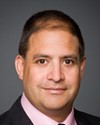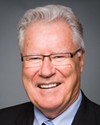First, I want to say good afternoon to everyone.
I want to thank you for having us and for the opportunity to be heard today. We are looking forward to our discussion and some questions after the opening comments.
My name is Bart Tsannie. I am the chief of the Hatchet Lake First Nation, which is in northern Saskatchewan, in the Athabasca region. We're about 724 kilometres northeast of Prince Albert, Saskatchewan.
Our first spoken language is Dene. Our people continue to live off the land and rely on the caribou for sustenance and cultural and traditional practices.
I am here with you today with my colleagues: Elder Jean Tsannie; the band councillor, Paul Denechezhe; our economic director, Anne Robillard; and the Athabasca land use coordinator, Diane McDonald.
Anne Robillard will present the economic development portion of our presentation, whereas I will briefly touch on land-use issues and how they tie into the social and economic aspects on and off reserve.
My colleague Diane McDonald will assist me with part of my presentation.
In our community in the Athabasca region, we understand that in most developed countries a secure land base is the key to the economy, equitable investments, revenues, and business partnerships on many other scales, including access to and extraction of our natural resources in the Athabasca region.
To improve current federal policies and practices for sustainable development and our economic opportunities, we need to work together with our neighbouring Denesuline communities on regional land-use planning and economic development as a priority in the Athabasca region.
In the early 1990s, northern Saskatchewan held joint panel reviews on uranium development focusing on the Athabasca region. A provincial government framework was to address a number of elements: communications and consultation, environmental planning, financial planning, employment planning, community and economic development, and the regulatory framework. This framework is not working today.
In Saskatchewan, public policy is failing to address these fundamental issues to achieve a balance in regard to the social and economic characteristics of our changing community in such areas as market conditions and the world price of uranium; the insufficient funding for improving the education and skill levels of the population; community social infrastructure; regional economic infrastructure, such as highways, etc.; financial services, such as development funds and revenue sharing; the high cost of living in poverty; and institutional conditions, such as local government facilities, etc.
In 1999 we entered into an impact management agreement with Cameco and AREVA in our regional communities in Athabasca as a result of the 1990s joint panel reviews, as we are the communities primarily impacted in Athabasca. The existing IMA is a community-company agreement, which addresses only some of the communication, environmental, social, and economic issues raised by our communities during the hearings of the 1990s, which are still ongoing concerns today. The initiatives supported by the IMA are shown in the table in the text of my remarks, a copy of which you have.
We want to offer some specific recommendations, based on our own experiences as leaders, to improve the living conditions and standards in our community.
We note that the B.C. government and first nations lead the way in the good, fair, and appropriate equitable partnerships. But our Athabasca communities, as the primary impacted communities, continue to live in poverty while multinational corporations benefit from our land and resources. To address these fundamental issues, we require great financial commitments by government and industry to continue to work collectively and create more modern partnerships so our people will have the economic sovereignty and prosperity needed to address the third-world living conditions we are faced with, including social programs and initiatives. These funds will need to include, but not be limited to, the following: local and regional funding commitments for participation in the duty to consult, accommodate, and reconcile; local and regional land-use planning initiative funding capacity; local and regional direct partnership agreements with government and industry, and the modernization of the benefit-sharing agreements, including negotiation funds and resource revenue sharing; local and regional infrastructure funding; local and regional training funds; and local and regional funding for social and cultural programs for youth and elders.
In land-use planning, we have formed a partnership with our Denesuline communities in developing a regional land use plan to manage the land and its resources. The Athabasca land use and management plan has been developed without the support for approval of the provincial government or the federal government. We request that the committee to take this matter seriously and assist us in revising the draft land use plan to make the necessary changes in light of the current changing world. We request assistance in funding, approving, and implementing our Athabasca land use plan. We want to prosper in our communities and manage the lands on reserve and off reserve in good partnership with both the federal and provincial governments.
With good governance, good management, and sound regulatory regimes and policies, we can prosper nation to nation and maximize the benefits and opportunities for promoting community development, and can direct input for business opportunities in a sustainable and balanced approach to the environment.
Land-use planning is one way of addressing aboriginal and first nations' treaty rights infringements from the development activities. It's a tool for good governance and decision-making; a good tool for management of the lands and resource use; a good tool to address the duty to consult, accommodate, and reconcile; a good environmental standard for protecting the environment and the people's health; and great for business opportunities and partnerships.
We want to stress that we have been stewards of our land for thousands of years and we want to ensure the continuation of the abundance of life we have shared with the Creator for many generations.
Millions of dollars have been allocated to deal with cleaning up the abandoned mines the most northern region of the Athabasca. These legacy mines have caused many barriers and hardships for our people to this day, but society seems to forget that we are the ones who faced the unknowns of uranium mining and their contamination to the environment, wildlife, fish, and our health, without any compensation.
And with the lack of business opportunities to maximize regional benefits from the cleanup, the Saskatchewan Research Council continues to promote out-of-province companies as the primary beneficiaries of the opportunities. Our people continue to be ignored and disrespected in many ways. We want this committee to address the matter before the environmental assessment is approved for the cleanup, meaning working with our people on a regional level.
Having said this, we also require full capacity for meaningful participation in the environmental assessment processes for these types of projects. The streamlining of environmental assessment processes does not address the duty of the crown to consult, accommodate, and reconcile. We require fair participation in these processes with meaningful participation in managing our land and resources for future generations.
The on-reserve Uranium Mine Ownership Act is currently undergoing proposed changes by the current government. The proposed changes should include the participation of our people. Our people should be consulted on this matter, and we request being included in the planning and discussions of the proposed changes, which may have a huge impact on our communities, and our aboriginal and treaty rights.
Lastly, I want to express that, according to the United Nations declaration adopted by the UN General Assembly in 2007, Canada needs to recognize the rights of indigenous peoples of Canada.
In closing, together we can do this and build a solid treaty, walk, share our passion, and make Canada stronger to move forward in building a good relationship with our Denesuline into the 21st century.
Again, Marci Chogh. Thanks for the opportunity for us here today to present our issue.
Thank you very much.











